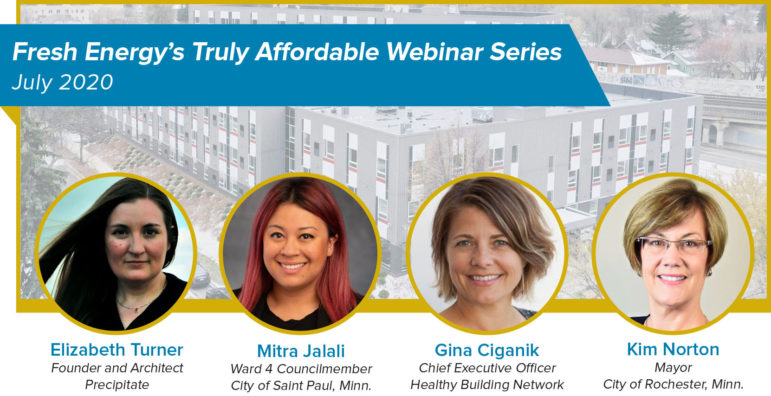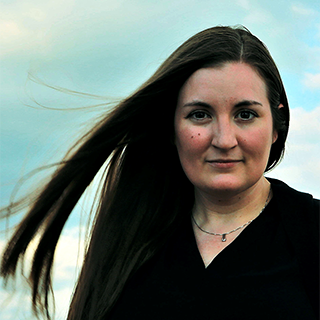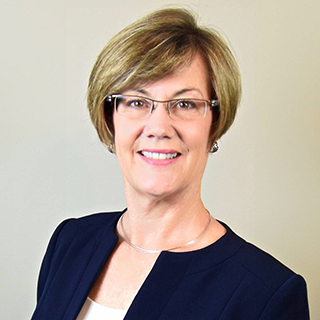How can super-efficient buildings become the new normal in equitable, affordable housing?

Minnesota is working hard to create more affordable housing. But if we build structures that are not super-efficient, residents will be saddled with high energy bills—and we will miss an opportunity to improve our built environment, a top source of carbon emissions in the state.
In July 2020, this was the focus of Fresh Energy’s four-part Truly Affordable webinar series. For this series, we brought together Minnesota thought leaders from the diverse areas of the affordable housing arena to discuss from their perspectives how super-efficient buildings can become the new normal in equitable affordable housing.
With the increased attention on affordable housing in this current crisis, we know that the conversation has only just begun. You can tune into each conversation below:
How can all-electric affordable housing really work?
Elizabeth Turner, Architect and Founder of Precipitate, joined Fresh Energy’s Margaret Cherne-Hendrick to discuss how with the right architecture and building science, super-efficient affordable housing is possible. This kind of work is critical to address the climate crisis at a community level, especially considering that building account for 40% of total energy use across Minnesota.
What’s the connection between energy and housing stability?
Saint Paul City Councilmember Mitra Jalali joined Fresh Energy’s Janiece Watts to discuss the perspective of tenants when it comes to efficient, affordable housing. Councilmember Jalali brought her experience as a renter, policymaker, and city leader to the conversation by digging into the deep ties between energy and housing stability, and the role these ties play especially during times of economic hardship.
Why is healthy, affordable housing so hard?
Gina Ciganik, Chief Executive Officer of the Healthy Buiding Network, joined Fresh Energy’s Ben Passer for a conversation about healthy, affordable housing from the perspective of a nonprofit developer and public health advocate. Gina shed light on how closely intertwined the energy efficiency of a building is with the health of its residents and how the choices developers make have long-term impacts on residents – especially when it comes to the building materials used construction.
How can cities lead?
Mayor Kim Norton of Rochester, Minnesota, joined Fresh Energy’s Justin Fay to discuss how cities can lead by building housing right the first time. Even though cities care deeply about ensuring high performing buildings are built, they can only set the efficiency bar so high when public money is involved. Using Rochester as an example Mayor Norton shared with us how the city effectively is spurring super-efficient development in the Destination Medical Center and their involvement in initiatives to change state law so cities like Rochester have the freedom to require that buildings be built better than the state code.
About the Speakers

Elizabeth Turner is an architect and founder of Precipitate, a firm that responds to the pressing social, economic, and ecological justice issues of today through deep listening and engagement, leading to holistic design at the intersection of architecture, research, policy, and education. As Passive House Consultant, Elizabeth pioneered pre-certification of the Hook & Ladder development—the first large multi-family project to PHIUS+2015 standards in Climate Zone 6A. This project is considered a “testing zone” for the industry and a model for super-efficient structures.

Mitra Jalali is the proud daughter of immigrants, a former classroom teacher, community organizer and policy aide who now represents Ward 4 on the St. Paul, Minn., City Council. Her main priorities in office include addressing the affordable housing crisis, community-first public safety, action on climate, and building community wealth.

Gina Ciganik is the Chief Executive Officer of the Healthy Building Network. In her previous role at HBN she established and led the HomeFree initiative, an expansion of HBN’s healthy materials work into the affordable housing sector. Prior to HBN, she was Vice President of Housing Development at a Minneapolis-St. Paul area affordable housing development organization, where she spent two decades creating thousands of healthy, affordable homes, including The Rose, a 90-unit apartment building that set a new national standard for healthy materials.

Kim Norton has been the Mayor of Rochester, Minnesota, since 2018 and represented the area in the Minnesota House of Representatives for 10 years. Kim won a 2016 Bush Fellowship, which allowed her to complete a master’s degree at the University of Minnesota’s Humphrey School of Public Affairs focused on energy policy and leadership. She has a strong commitment to ensuring that Rochester’s Destination Medical Center and many other new developments are super-efficient and is partnering with more than 20 Minnesota cities on a policy to allow cities the option of adopting a standard that is more ambitious than the current state energy code.
THANK YOU TO OUR EVENT SPONSORS
THANK YOU TO OUR PROMOTIONAL PARTNERS
The American Insitute of Architects Minnesota
Climate Generation
Conservation Minnesota
Midwest Building Decarbonization Coalition
Midwest Energy News
Midwest Renewable Energy Association
MnSEIA
Pollen
Sierra Club
TakeAction Minnesota

